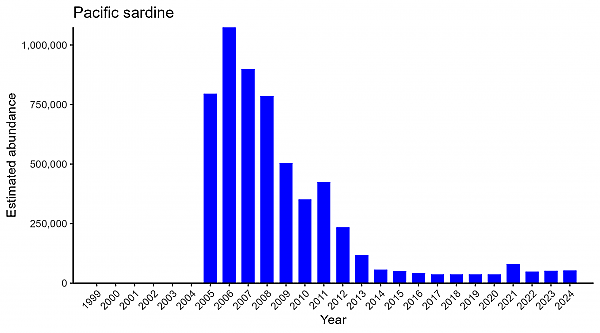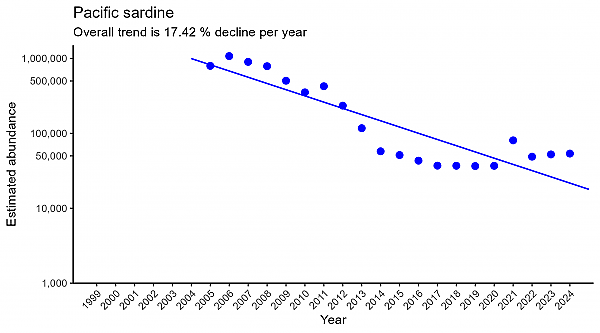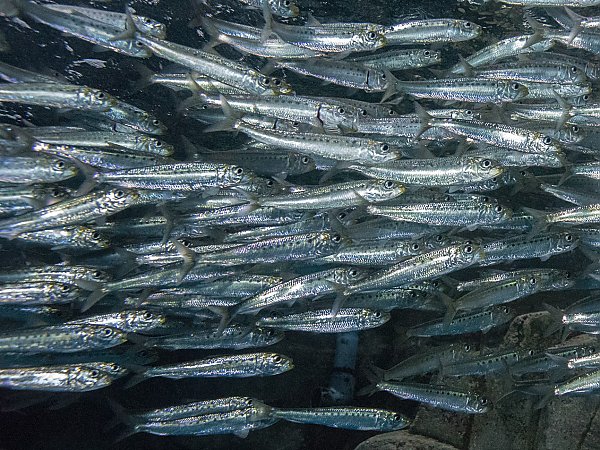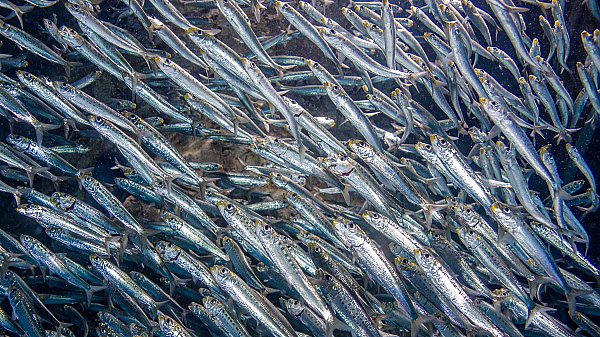Pacific Sardine
Sardinops sagax
Pacific Sardine
Sardinops sagax
Morphology
Pacific sardines are elongated pelagic fish known to form large dense schools near the ocean surface – a behavior that helps protect them from predators. They use their large eyes and excellent eyesight to locate dense patches of prey in the water. Most individuals are under 30 centimeters in length, but some can get to be over 40 centimeters. This elegant fish uses countershading to camouflage itself from predators above them in the water column. Countershading entails blue-green coloring from above, and silver bellies underneath.
Habitat and Range
Pacific sardines inhabit coastal waters as well as open ocean environments. They are found in the Indo-Pacific and East Pacific oceans and the Gulf of California. The distribution of Pacific sardines is closely tied to sea surface temperatures. During warmer periods, sardines expand their range northward, reaching as far as British Columbia, Canada. Conversely, during cooler periods, their range contracts, and they are seldom found north of Point Conception, California.
Range Map

Reproductive Biology and Life History
Pacific sardines can live up to 13 years, although most do not surpass 5 years of age. They grow rapidly and can reach lengths of over 30 centimeters. Sardines reproduce by their second year and spawn multiple times per season. Females release up to 45,000 eggs per spawning event, which are fertilized externally in the water column.
Ecology
Pacific sardines are a crucial forage species in the California Current Ecosystem, transferring energy from lower to higher trophic levels. They serve as a significant food source for many marine mammals, fish, seabirds, and pelagic invertebrates. Historically, sardine populations have exhibited cyclical fluctuations over approximately 60-year periods, which are believed to be linked to changes in oceanic conditions, particularly temperature. Sardines undertake seasonal migrations along the Pacific coast, moving to feeding grounds in the north during summer and returning to spawning grounds in the south during winter. These migrations are closely tied to environmental conditions and the availability of food resources.
Culture and Historical Context
Pacific sardines supported the largest commercial fisheries in the western hemisphere in the 1920s to 1940s, peaking at over 700,000 metric tons harvested per year. At its peak, the sardine fishery played an important role in California coastal economy, with “Cannery Row” in Monterey, California, made famous by John Steinbeck, representing the legacy of this now collapsed fishery. The population decline was so severe – that at its low point it was estimated that sardines had declined to a spawning biomass of only 10,000 metric tons. The population has never recovered to its historical peak levels but did recover enough to be harvested again in 1999 before experiencing another collapse – a 95% decline from 2006 until 2017.
This animal can be found at the Aquarium of the Pacific
Primary ThreatsPrimary Threats Conditions
Threats and Conservation Status
The original decline in the Pacific sardine population was due to overharvest and unfavorable oceanic conditions. Currently, there is a moratorium on commercial fishing for sardines off the coast of California, Oregon and Washington. However, sardines can be harvested for bait or as part of incidental catch in other fisheries. As can be seen from the population estimates from 2005 onward, the population has been steadily declining by more than 20%. In particular, the annual decline of 17.4% explains 78% of the year-to-year variation in sardine estimated abundance. These data are for the northern Pacific subpopulation of sardines, which extend beyond California up to Vancouver Island, Canada.
The complexity and boom and bust nature of sardine population dynamics makes it difficult to predict population trends accurately and to manage the species effectively under changing ocean conditions. The intent of the current moratorium on Pacific sardine harvest is to allow the fishery to rebuild and restore the stock by 2035. However, the string of almost ten straight years of decline evident in the graphs we show suggests recovery is not yet happening.
Population Plots


Data Source: Data obtained from NOAA: PT Kuriyama 2024 — 2024. Assessment of the Pacific sardine resource (Sardinops sagax) in 2024 for U.S. management in 2024-2025. U.S. Department of Commerce, NOAA Technical.


